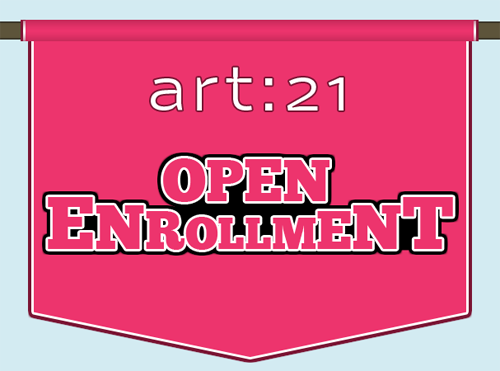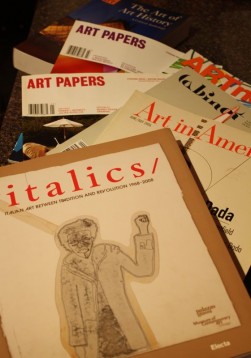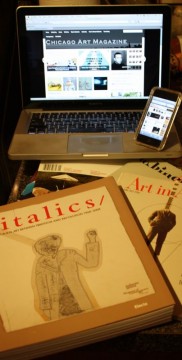This fall, I will be beginning my final year as a Masters candidate in New Arts Journalism (NAJ) at The School of the Art Institute of Chicago (SAIC). According to SAIC, this very new arts journalism program is diverse, giving students the skills needed to attain a place as art and design journalists in an array of fields from magazines and newspapers, to radio and television, to new media outlets such as blogs and podcasts. There is a definite breadth here — an overwhelming breadth — to this mission, and this evokes feelings of sheer terror and immeasurable excitement about the future of the field.
I asked a colleague of mine, Whitney Stoepel, about some of the issues I was thinking about when composing this post. Whitney is also a year away from graduating with a Masters in New Arts Journalism from SAIC, and she and I are both learning from wonderful professors who are successful in the field of arts journalism, albeit predominantly in print mediums. While we learn from them, we also hear about the impending death of print due to the unstoppable draw and cost-effective platform that is the Internet. To my question, Whitney asked a very good one. She said, “How do you find teachers with years of experience in the field when the field itself is undergoing a complete transformation?” She continued, “We are young and we have a chance to make the new way our way. We’re not tethered to newspapers or a top-down editorial structure. We can be our own bosses. We are part of a generation that’s old enough to understand change and young enough to master the new technologies that aren’t going to stop evolving anytime soon.”
Whitney’s answer is confident and hopeful for arts journalism students like ourselves, but in this statement lies a tough road ahead — or so it seems to me. As a publishing poet, published only in print, I am feeling the death of print not only in my future as an arts journalist, but also as an artist. These two perspectives make thinking about this all the murkier, more unknown, and more overwhelming. But these perspectives also make all of this wholly invigorating, giving the passion I already possess for the arts an incentive to make them a constant element in the world through writing, marketing, and cultural enrichment.
According to the broad spectrum put forth in SAIC’s statement about the NAJ program, I am hardly limited to writing. At the same time, writing is what I know best. It is something I know I am able to do successfully — but only if I may secure an opportunity in this compromised economy. Even with the death of print upon us, writers will be needed, and it will be necessary for them to be amenable to any form or medium that may take.
My colleague Whitney’s perspective on her work now and in the future is one born out of passion, and that is really why we are all in the arts. She is not limiting herself to writing; rather she is spreading enrichment. She said, “I want to work at a not-for-profit arts organization where I feel like I’m helping people, creating awareness of and for the arts. And I want to write on the side, freelance. Strong writing and editing skills are hard to come by in a younger workforce and [they are] an asset.”
In our NAJ program at SAIC, we take theory and art history classes as well as journalism classes, and this is a definite comfort to me as I prepare to re-enter the workforce. A strong background in theory is needed to keep up with the evolving arena of art, and of course art history is a necessary context for arts journalists. But in thinking of all of this, I am again a part of an amalgam of dust and mud that is the gyre of this field in the twenty-first century. In one of these classes, we read SAIC professor James Elkins’s piece, “On the Absence of Judgment in Art Criticism,” a bleak read indeed. The bleakness came from Elkins pointing out the lack of readership for art writing, that art historians do not read the work of critics and critics do not keep up with the scholarly writing of art historians. This is bleak because for me these two fields are forever commingled, just as a divorced couple is commingled through its children.
So all of this considered, I am left still wondering where and what will arts journalism be in the twenty-first century. I think there needs to be a balance between print and online writing, including podcasts. But no matter what the medium, it all has to be strong, thoughtful, and well-edited. Trained, skilled, and passionate art journalists such as Whitney and myself will indeed be an asset to the world of arts journalism even if print is a thing of the past.
That said, in my view, print will never be completely gone. There will always be glossy magazines and journals that fancifully showcase the artwork discussed within its pages, and there will always be exhibition catalogues. However, there is also a crack in the curatorial door where established art journalists may be allowed entry. Glossy magazines and journals as well as catalogues are often artful in their own right, and that is the main reason I believe they will have staying power.
As far as newspapers go, I think both columns and staff will be cut back again and again, much of them moving to the online market. But in the world of newspapers, institutions such as The New York Times will always have a firm footing in a technology-riddled world. For radio, an enriching organization like National Public Radio will continue to experience a growing audience.
The question is how to attain one’s own individual aspirations, and as Whitney said (and I aptly agree), we are the new generation of journalists and we will be able to construct this landscape in our own ways. Though this is a rather daunting and overwhelming prospect, it is also one that is incredibly exciting.
My career goals are beginning to lean toward marketing for a nonprofit arts organization or a museum, and to continue writing freelance for the arts, much like Whitney’s plan. And I would be willing to guess our aspirations are not unique for others in the field either. Approaches now are truly varied and diverse in these days of Internet-as-monolith. I am in my thirties and I am in an interesting position of knowing of when there was no Internet in the world and knowing it as it now exists. At the same time, I am young enough to be tuned in to this new instantaneous landscape no matter what form the majority of arts journalism will come to take.
Carrie McGath holds an MFA in Poetry from Western Michigan University. Carrie’s first collection of poems, Small Murders, was released in 2006. She self-published two chapbooks of poems in 2007-8. Carrie attends The School of the Art Institute of Chicago’s New Arts Journalism Masters program. She is a contributor to Chicago Art Magazine and SAIC’s F News Magazine.





